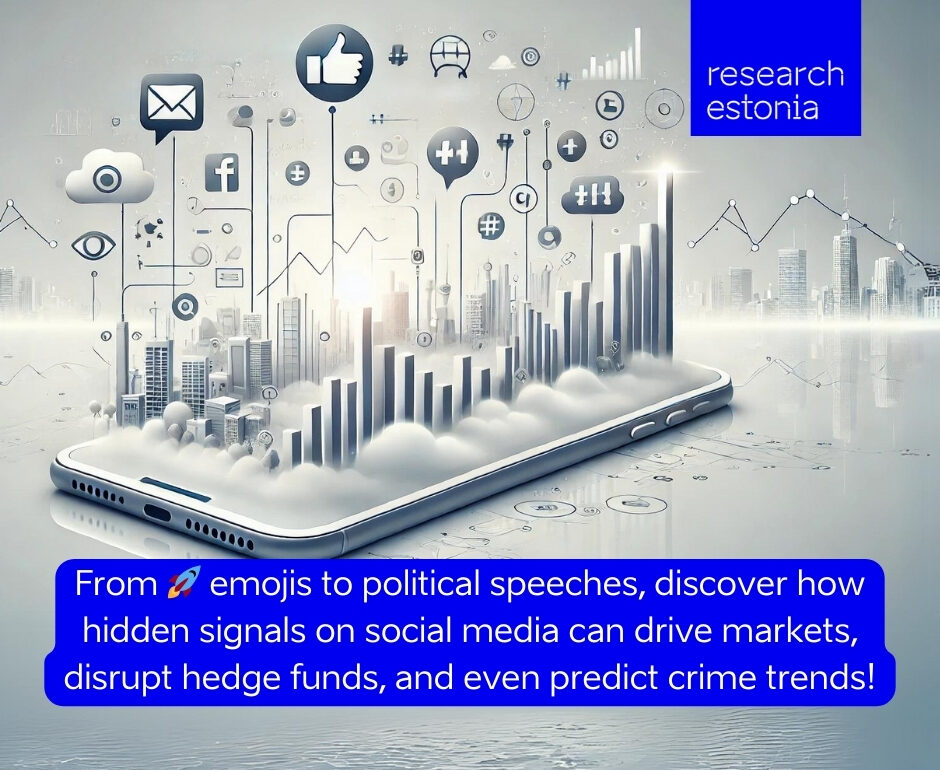Table of Contents
Recent events show that social media allows anyone to influence topics ranging from stock market reactions to political elections. My research shows how tracking irrational reactions to daily events can predict asset price changes and even crime rates. This information can benefit private investors for short-term predictions and public authorities for resource allocation.
Since the beginning of the 1990s, humankind has experienced the largest leap in information technology that it has seen during its entire existence. Average consumers now have more information available than ever before to back up their decision-making related to their consumer behaviour.
Additionally, the same technological advancements have occurred in marketplaces through the internet and smart phones. Nowadays it is no longer necessary for the consumers to go to the store to do the grocery shopping or to the bank to trade stocks, like it was in the beginning of 2000s. All of this can now be done within seconds from home through mobile applications.
In my view, these advances also challenge the current classical asset pricing models, which were mostly created between 1970s and 2000s. These models mainly assume that investors are always rational in their decision-making and their only motive is always profit maximisation for their investments.
These assumptions were necessary at the time because they kept the models understandable and easy to calculate by the human mind. This approach also may have been a better fit when the number of counterparties transacting in stock markets was limited by the technological constraints mainly to counterparties, whom we nowadays call institutional investors.
In addition, the channels for individual opinions and statements, which we generally refer to as information, were limited to media like newspapers, television and radio. To get your voice heard through these channels required a private individual to have a certain level of credibility and social standing in the community. It was nearly for a one single individual impossible to achieve this.
Social media platforms like Facebook, and Twitter (X) completely changed the game. They offered a platform for individuals and institutions to share their opinions and statements to the public without any kind of filter and in real time. From the perspective of democracy and freedom of speech, this kind of situation may seem ideal, but it also has darker sides. For instance, it works as a perfect channel for disinformation to reach us, which, in worst case, can affect our decision-making.
Social media and stock market
In my own research, I have focused on such events for the past three years. I have created my own tools to monitor and analyse the most traditional social media platforms and the asset price movements in the market, to find pairs where the movement of a stock, for example, could be momentarily explained by the information published in social media.
My first article focuses on the case of Wall Street Bets Reddit group and the stock of Game Stop (GME) in the spring of 2021. In this case, the discussion in this social media platform was able to create a campaign among private individual investors, whose actions were able to challenge the institutional investors like hedge funds in the market.
The private investors aimed to counter the hedge funds that heavily shorted Game Stop stock, hoping to preserve a piece of their childhood, at least according to their own narrative. At first, the discussions on the platform instructed investors to buy large quantities of stock, which many people did. This caused the stock price to increase in the market, which was the opposite of what the hedge funds had forecasted. They predicted a short-term decrease and aimed their short-selling instruments accordingly.
What is short selling?
For those who are not familiar with financial terminology, short selling is a financial strategy where an investor borrows shares of a stock and sells them on the market, betting that the stock price will decline. The goal is to buy back the shares later at a lower price, return them to the lender, and pocket the difference. If the stock price rises instead, the investor faces potential losses, as they must buy back the shares at a higher price. Short selling is considered a high-risk strategy, as losses can be theoretically unlimited if the stock price continues to increase.
This group of retail investors coordinated a effort to buy shares and call options in GameStop on this platform, aiming to trigger a “short squeeze” against hedge funds that had heavily shorted the stock, betting on its further decline. As more retail investors piled in, GameStop’s stock price soared from about $20 to a peak of nearly $500 in just a few weeks. This rise forced some short-selling hedge funds to close their positions at massive losses, as they had to buy back shares at much higher prices to cover their shorts.
During these peak moments, my research findings suggest that when a stock is going through this kind of publicity, market or industry indexes are not efficient variables to predict the asset price movement. Instead of these traditional variables, I used different types of variables in my own research, such as the 🚀 emoji or sentence like “To the moon” and their daily variance among the discussions on the Twitter and Reddit platforms. In these peak spots, these variances were able to explain the variance in stock price movement better than the industry or market indexes.
This suggests that even completely irrational information could move and transform into market prices, and that is why it is important to us to understand this possibility and move our forecasting to be based on the information available before private individuals make their investment decisions.

Asset pricing and crime statistics
Identifying these variables in time could offer investors opportunities to make short-term investments and cash them out. For government institutions, this information could be helpful to prevent possible attacks through disinformation targeting the market. For law enforcement, acknowledging that these prices could carry information might be useful also. For example, when attempting to determine possible routes for illegal substances to Estonian market.
This is where my second article is focused. In this article, I examined how the wholesale prices for cocaine and cannabis on two different Darknet sales platforms correlate with quarterly crime statistics in Estonia. I am still conducting this research, but my early-stage findings suggest small correlation between changes in cocaine price in Spain and crime statistics in Estonia, as well as a similar correlation between cannabis prices in Netherlands.
Although these findings provide results that could be seen as statistics response on questions that typically have been answered by more non-scientific methods through criminal investigations. By mapping the possible trafficking routes of narcotics through this approach could save hundreds of hours in investigative work and help authorities to map the possible trafficking routes and prevent the substances arrival to the market even more efficiently. In this case, my plan is to show that this transformation could occur in another way as well, where the “asset price” could generate other types of information, like crime statistics in this case.
Crypto market and the political information
My third and final example of this new-age linkage between information and asset prices comes from politics and shows, how political information may even affect unregulated assets such as cryptocurrencies. I got the data and idea for this research topic while monitoring the news and market in February 2024.
Using my tools, I detected a similar kind of correlation with Bitcoin’s price and Tucker Carlson’s interview with Vladimir Putin, just as I did with Game Stop and rocket emoji. This correlation was strongest when applied to three-hour lag into the results. The outcome was that each time when the speech was given to Putin during the interview the price of Bitcoin (BTC) increased 1106 euros during the interview. Similar kind of effect could be seen in exchange rate between GBP and BTC, but with BTC and USD the correlation on this specific moment was the weakest.
This research is also still ongoing. My idea is to include the most recent events in US politics to see their impact on cryptocurrencies. Early-stage findings in this case have shown that figures with high authority over their followers may trigger people to conduct transactions in the market.
For example, in case of Vladimir Putin’s interview, small peaks in Bitcoin price could be noted after his speech during the interview. In the case of Russia, it is also important to note that cryptocurrencies currently offer only way to send funds directly to Russia due to sanctions. This means that acknowledging this type of event could help Western world make sanctions more effective by tracking the counterparties in these trades to the extent that it is possible.
Conclusion
Together, these findings demonstrate, that to predict markets in the future and understand the ever-changing investor behaviour, it would be beneficial to move from analysing transactions that have already occurred to analysing the content where individuals express their intentions to transact in certain way.
In the past, this type of analysis wasn’t possible due to the technological constraints, but advancements in AI and computational power now make it possible.
As a private individual, my ultimate dream for me personally would be for these findings to someday trigger more research in the field and to commercialize this work. I would like this to happen in Estonia, the country that has personally given me the education and possibility to get this far.
Author of this article is Samuli Saarinen. Editor Jaan-Juhan Oidermaa.
Article written for the contest “Science in 3 minutes” organised by Estonian Academy of Sciences and The Estonian Young Academy of Sciences (EYAS). Main sponsor of the competition is Inclusive Financial Technology Foundation.
If this dive into social sciences has you hooked, don’t just people-watch — people-read! Head over to our next article and uncover more about how Social Media Influencers Can Help Rebuild Women’s Body Confidence!
 Back
Back



